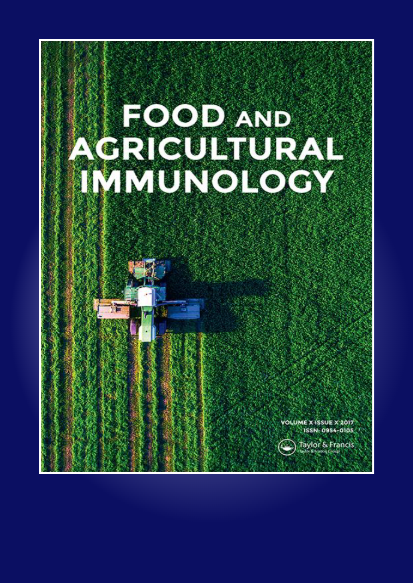多重免疫层析法同时检测鸡肌肉中三种聚醚离子载体抗生素的建立
IF 2.1
3区 农林科学
Q3 CHEMISTRY, APPLIED
引用次数: 0
摘要
建立了一种快速、可靠、灵敏的多重胶体金免疫层析法(CGIA),用于同时检测鸡肌肉中三种聚醚离子载体抗生素(PEs)。优化后的CGIA的IC50值分别为1.63、1.94和1.18 ng/mL,分别在0.87 ~ 3.04 ng/mL、0.85 ~ 4.41 ng/mL和0.57 ~ 2.44 ng/mL的线性范围内。截止值分别为10、5和5 ng/mL。整个检测过程在15 min内完成。采用液相色谱-串联质谱(LC-MS/MS)对盲鸡肌肉样品进行平行分析,制备的CGIA未出现假阳性和假阴性。结果表明,所建立的方法可为鸡肌肉样品中PEs残留的现场筛选和检测提供快速有效的方法。本文章由计算机程序翻译,如有差异,请以英文原文为准。
Development of multiplex immunochromatographic assay for the simultaneous detection of three polyether ionophore antibiotics in chicken muscle
A rapid, reliable, sensitive, and multiplex colloidal gold immunochromatographic assay (CGIA) was developed for the simultaneous detection of three polyether ionophore antibiotics (PEs) in chicken muscle. The IC50 values of the optimized CGIA were 1.63, 1.94, and 1.18 ng/mL with a linear range of 0.87–3.04 ng/mL, 0.85–4.41 ng/mL, and 0.57–2.44 ng/mL for maduramicin (MAD), monensin (MON), and salinomycin (SAL), respectively. The cut-off values were 10, 5, and 5 ng/mL, respectively. The whole testing process was completed within 15 min. A parallel analysis in blind chicken muscle samples was conducted by liquid chromatography–tandem mass spectrometry (LC-MS/MS), the developed CGIA did not appear false-positive and false-negative. The results show that the established method could provide a rapid and effective approach for on-site screening and determination of PEs residues in chicken muscle samples.
求助全文
通过发布文献求助,成功后即可免费获取论文全文。
去求助
来源期刊

Food and Agricultural Immunology
农林科学-毒理学
CiteScore
5.30
自引率
6.70%
发文量
52
审稿时长
2 months
期刊介绍:
Food and Agricultural Immunology is an international open access journal publishing original immunological research with applications in food, agricultural, environmental and veterinary science. Submissions describing the use of immunological techniques and methods are particularly welcomed.
The journal aims to expand our understanding of the interactions at the interface of food and immune systems including studies on:
-Development of diagnostic systems – all types of ligand-based assays, e.g. antibody, aptamer
-Application of ligand-based assays for the detection or identification of molecules of interest in food science, agricultural research, veterinary investigations and clinical systems relating to food allergy or sensitivity to agricultural chemicals
-Effects of food on the immune system
-Studies on allergy and allergic reactions
-Investigations into food allergies
-Development of allergen-free food systems
-Development of novel assay formats
-Applications of assay systems to the monitoring of food items in relation to safety and labelling
-Food quality issues, e.g. speciation, adulteration and contamination
-Comparisons between different analytical techniques
The journal publishes research and review articles and is essential reading for food scientists, immunologists and all those concerned with the interaction between food and immune systems.
 求助内容:
求助内容: 应助结果提醒方式:
应助结果提醒方式:


